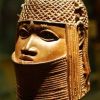පිත්තල වාත්තු කිරීම
Coconut oil lamps, pots, bowls, vases, wall plaques, trinket boxes and other household utensils are made with cast technique. Brass Castings are done by the “lost wax” method: the model is sculpted in wax, covered with clay, and baked so that the wax is melted out leaving the mould made of clay. Then the clay mould is poured with the molten Brass. The casting technique produces fine Brassware of elephants, Buddha images, bowls, lamps and candlesticks.
To make these products even more attractive, local craftsmen engrave the brassware with natural style motifs such as flowers, leaves, fruits and even sceneries. Silverware, like Brassware is a specialty of the Kandyan provinces. Ornately carved and filigree jewellery, trays, trinket boxes, tea-sets, candle-stands, cutlery and ash-trays.
Brass is an alloy made of copper and zinc; the proportions of zinc and copper can be varied to create a range of brasses with varying properties.[1] It is a substitutional alloy: atoms of the two constituents may replace each other within the same crystal structure.
By comparison, bronze is principally an alloy of copper and tin.[2] Bronze does not necessarily contain tin, and a variety of alloys of copper, including alloys with arsenic, phosphorus, aluminium, manganese, and silicon, are commonly termed "bronze". The term is applied to a variety of brasses and the distinction is largely historical,[3] and modern practice in museums and archaeology is increasingly to avoid both terms for historical objects in favour of the all-embracing "copper alloy".[4]
Brass is used for decoration for its bright gold-like appearance; for applications where low friction is required such as locks, gears, bearings, doorknobs, ammunition casings and valves; for plumbing and electrical applications; and extensively in brass musical instruments such as horns and bells for its acoustic properties. It is also used in zippers. Brass is often used in situations where it is important that sparks not be struck, as in fittings and tools around explosive gases.
Listing Details
Address
ශ්රී ලංකාව, ශ්රී ලංකාව







